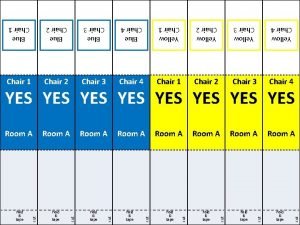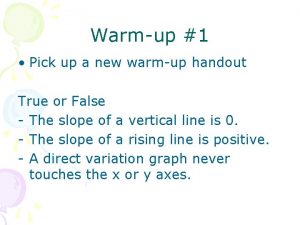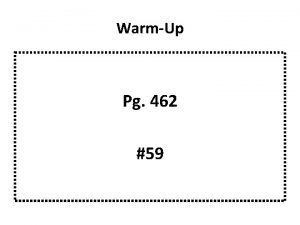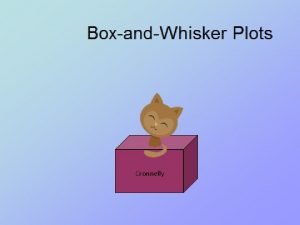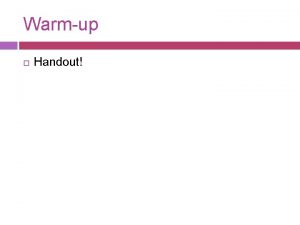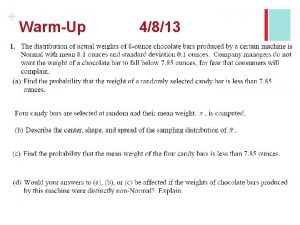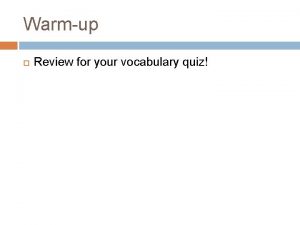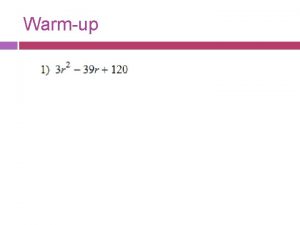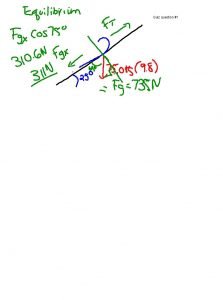WarmUp Pick up a quiz from the chair



























- Slides: 27

Warm-Up Pick up a quiz from the chair and begin. You will have 7 mins. No talking.

Test Details 2 hrs. , 45? always read all answer choices!!! Finals Schedule: Period 1: Wednesday Period 2: Thursday Period 3: Friday Period 4: Following Tuesday (1/19)

Where water can be found GROUNDWATER: water that is stored underground in the cracks and space of soil, sand, and rock. -Moves slowly

Where water can be found SURFACE WATER: water found over the land surface in streams, oceans, rivers, ponds, marshes, lakes, etc. -Moves quickly

Where water can be found Water table: the level below which is saturated (full) of water

Where water can be found Zone of Saturation: level beneath earth’s surface where pore spaces are filled with WATER Below the water table

Where water can be found Zone of Aeration: level beneath earth’s surface where pore spaces are filled with AIR Above the water table

Quick Check 1. Through which process of the water cycle could rainwater seep into the ground to become groundwater? 2. Following a snowstorm, water slowly makes its way into an aquifer located above impermeable clay. Which type of aquifer does this describe? 3. If water is removed from a well faster than the aquifer can be recharged, what will happen to the water table near the well? 4. During a flood, where is the water table located?

Permeable vs. Impermeable Surfaces This is an example of an impermeable surface Discuss with your partner what you think an IMPERMEABLE SURFACE might be

How does the amount of runoff compare?

How does the amount of INFILTRATION compare?

Which of the pictures shows a ground cover with a HIGHER PERMEABILITY?

Quick Check 1. True or false. We have new water today than we did millions of years ago 2. Complete the sentence. Permeable surfaces have ________(more or less) runoff and therefore _______ (more or less) infiltration than impermeable surfaces?

Motions of the Oceans Waves, Tides, & Currents

Waves Disturbance which moves through/over the surface Mostly caused by winds (also earthquakes, volcanoes, and grav. pull) Influence coastlines (erosion, weathering) returns O 2 to water stirs up food for filter feeders

Tides Rhythmic rise and fall of ocean water Caused by: grav. pull of moon (and sun)

Tidal Range

Spring Tides moon and sun are in line causes high tidal range

Neap Tides sun & moon at right angle unusually low tidal range

Types of Tides Diurnal: 1 high and 1 low per day Semi-diurnal: 2 high and 2 low per day- here! Mixed: 2 high and 2 low per day (various heights)

Currents Like “rivers” of circulating water in the oceans Caused by… wind rotating earth density changes

Surface Currents Move in circulating gyres Stay on one side of the equator Rotate clockwise in the N. hemisphere, counterclockwise in the S. hemisphere (Coriolis)

Deep Currents Move all around the globe Driven by density differences Thermohaline (temp and salinity) aka global conveyor belt

Wetlands Valuable ecosystems Act as filters for water Absorb flooding

Heat capacity

Exit Ticket 1. Subsurface ocean currents continually circulate from the warm waters near the equator to the colder waters in other parts of the world. What is the main cause of these currents? a. differences in the topography along the ocean floor b. differences in density of ocean water c. the rotation of Earth on its axis d. movement of the jet stream 2. What is most responsible for the presence of groundwater in an area? a. the movement of water from a confined aquifer into surface water b. the movement of surface water and precipitation through soil and rock c. the movement of water from streams and rivers to watersheds d. the movement of surface water through impermeable rock 3. Explain the causes of tides, currents, and waves. (3 causes!)

Plate Tectonics Options Go to bit. ly/1 UCs 2 Mj Choose one of the following options 1. pgs. 21 -22 2. pgs. 29 -30 3. pgs. 34 & 39
 Tinman schwartz
Tinman schwartz Status vs class
Status vs class Java warmup
Java warmup Warmup ratio
Warmup ratio 65 mins
65 mins Surface area warm up
Surface area warm up Define:warmup
Define:warmup Warmup 65
Warmup 65 Warmup end
Warmup end Mind rhyming words
Mind rhyming words Ethos warmup
Ethos warmup Gmass warmup
Gmass warmup Multiplying exponents
Multiplying exponents ưu thế lai là gì
ưu thế lai là gì Thẻ vin
Thẻ vin Thể thơ truyền thống
Thể thơ truyền thống Cái miệng nó xinh thế
Cái miệng nó xinh thế Các châu lục và đại dương trên thế giới
Các châu lục và đại dương trên thế giới Bổ thể
Bổ thể Từ ngữ thể hiện lòng nhân hậu
Từ ngữ thể hiện lòng nhân hậu Diễn thế sinh thái là
Diễn thế sinh thái là Tư thế ngồi viết
Tư thế ngồi viết Thứ tự các dấu thăng giáng ở hóa biểu
Thứ tự các dấu thăng giáng ở hóa biểu Phép trừ bù
Phép trừ bù Bài hát chúa yêu trần thế alleluia
Bài hát chúa yêu trần thế alleluia Hươu thường đẻ mỗi lứa mấy con
Hươu thường đẻ mỗi lứa mấy con đại từ thay thế
đại từ thay thế
































